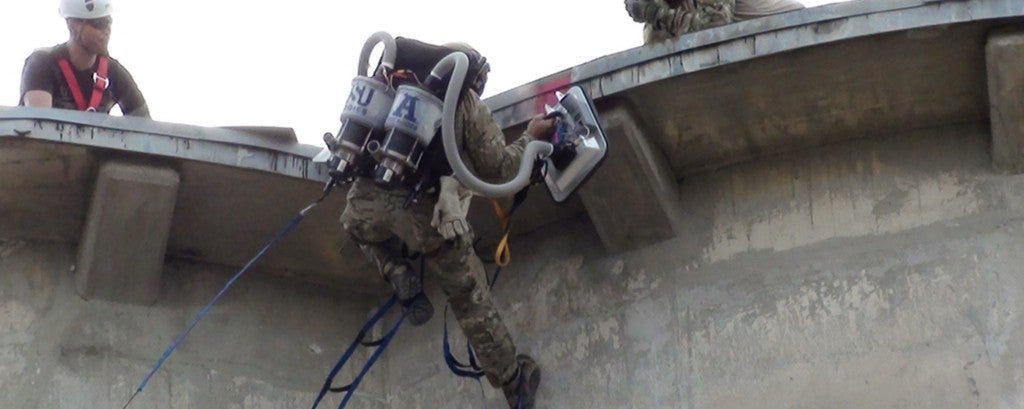One hour ago, Steve from Virginia, the brave young man who decided to climb up the Trump Tower in Manhattan as some form of protest (against…American democracy?) was stopped from reaching his ambiguous goal when the police yanked him inside the building.
Steve had been climbing using a collection of five simple suction cups, painstakingly wiping the windows of the Trump Tower as he went along to ensure a good seal. Steve climbed for hours. Steve didn’t make it very far.

But four years ago, a team of engineering students at Utah State University designed a system they called a Personnel Vacuum Assisted Climber, or PVAC, which makes it possible to climb up the side of buildings at a rate of about two stories every 30 seconds. If Steve had been strapped into one of these, he’d have been able to get to the top of the 58-story Trump Tower in about 15 minutes, allowing for a breather halfway up.
So I called up another Steve, Steve Hansen, the professor (now retired, and camping near the Utah-Idaho border) who led the student PVAC team, to ask him about Steve from Virginia’s choice of climbing methods, how they came up with the PVAC idea in the first place and if it might be coming to a Trump-disrupting store near you anytime soon.

The videos show the PVAC being used on brick walls, but would it have been equally effective on the glass of the Trump Tower?
It would have no problem adhering to glass, because it’s so smooth.
When we designed ours, it was for a contest for the Air Force, and we didn’t know what the wall was going to be like—they said it was was going to be a wall, so we assumed it could be rock, it could be brick, it could be anything. So the students designed the edge of the suction cup so that it would adhere to basically anything.
What do you think of Steve’s technique?
It looks like he has a bunch of suction cups, one attached to each leg and each arm. It looks pretty cumbersome.
How did the team come up with the idea of using a vacuum to climb up a wall?
One student had the idea, and he convinced the rest of the team to go with it. We bought a vacuum cleaner replacement motor online, just something standard, like from a Dyson, and then just worked on the design until it got better and better. Then we took it to the competition, and we were the only team that actually met the challenge.
What was the challenge?
To get four people up a 90-foot wall without a grappling hook. And the students weren’t allowed to climb—we had to train Air Force personnel to climb.
We figured if we built two systems, and trained two people to use them, they were gonna be so competitive to get to the top first they’d climb even faster. And it worked perfectly, they just raced the whole way up, then each dropped a line to bring up the other two guys.
Is it hard to train someone to use a PVAC?
No, it’s really easy to use. I could explain how to use it to you over the phone, and you’d have no problem climbing up a wall. We let high school students come into the lab and use it.
What does it take to actually move up the wall?
Your feet are connected to each suction pad by a line, and once it’s stuck on the wall, the pad supports your leg and your arm. That lets you climb with your legs, instead of your arms, which are much stronger muscles.
Then each suction pad has a trigger, like a bike handle, that you reach up to break the vacuum seal around the edge. Once one is loose, you just pull it off the wall and re-stick it further up.
How long was the battery life?
About 20 to 30 minutes. The batteries ended up being the heaviest component in the system.
Could Steve from Virginia have built a PVAC at home?
It would be pretty hard to make it from scratch, but if you took the design the team ended up with, sure.
How much would a PVAC cost to build?
Probably around $1500 or $1700 to make one, because of the machining and everything involved.
Did you ever consider making this a consumer product?
We did, and some of the students who designed it would have loved to see it go to market. But you need a real infusion of money to do something like that.
Did the Air Force not want to buy it?
They did in fact pay for our advanced design, which we made the year after the initial PVAC project. We assume they’re using it.
But did you or anyone on the team patent the PVAC?
It turns out it’s not patentable. If you google and search back about 10 years, there was one of these built by, I believe, a British gentleman. In the United States, you have one year after making something public to patent it, so by posting about it on the internet he made it unpatentable.
So anyone can just start manufacturing these?
Anyone can go make one right now. It’s public domain.
